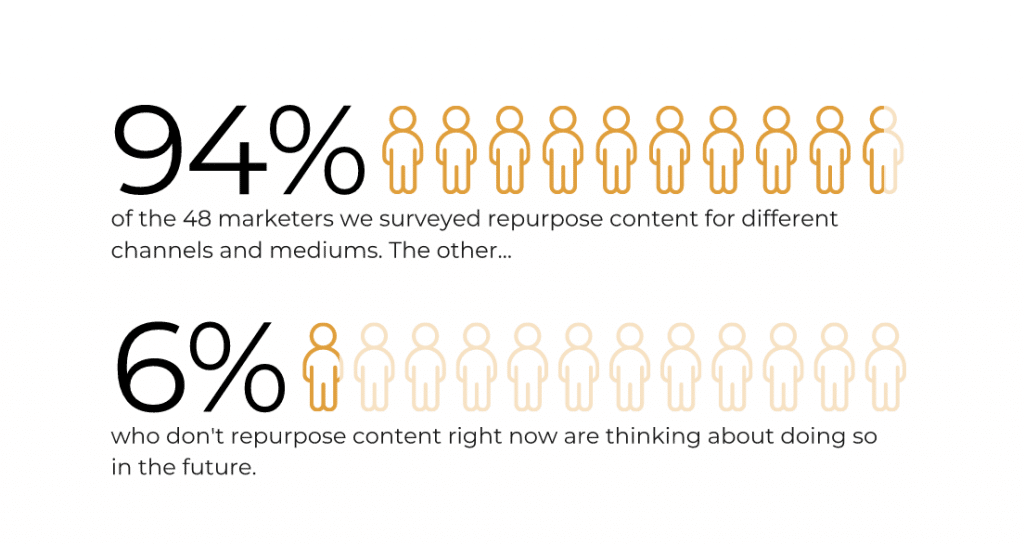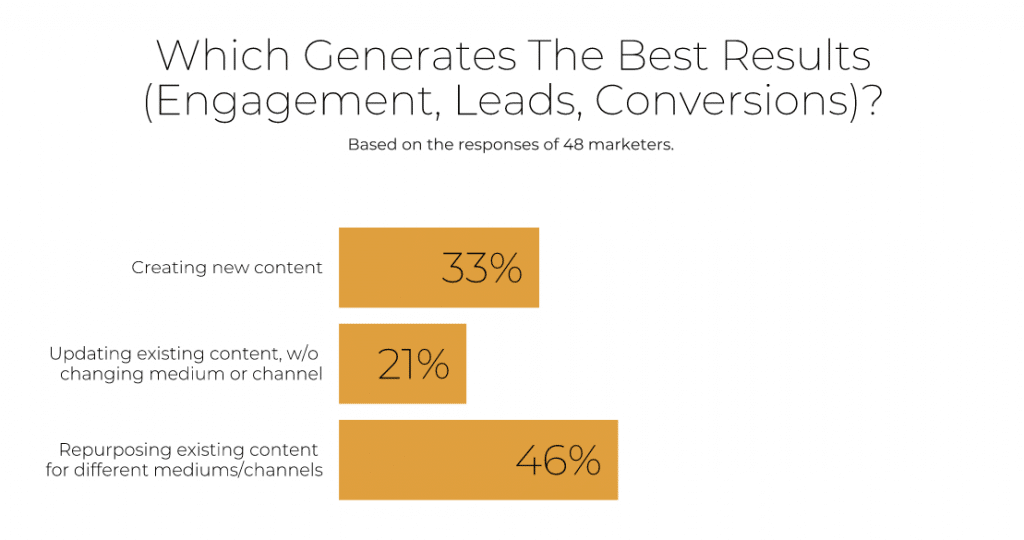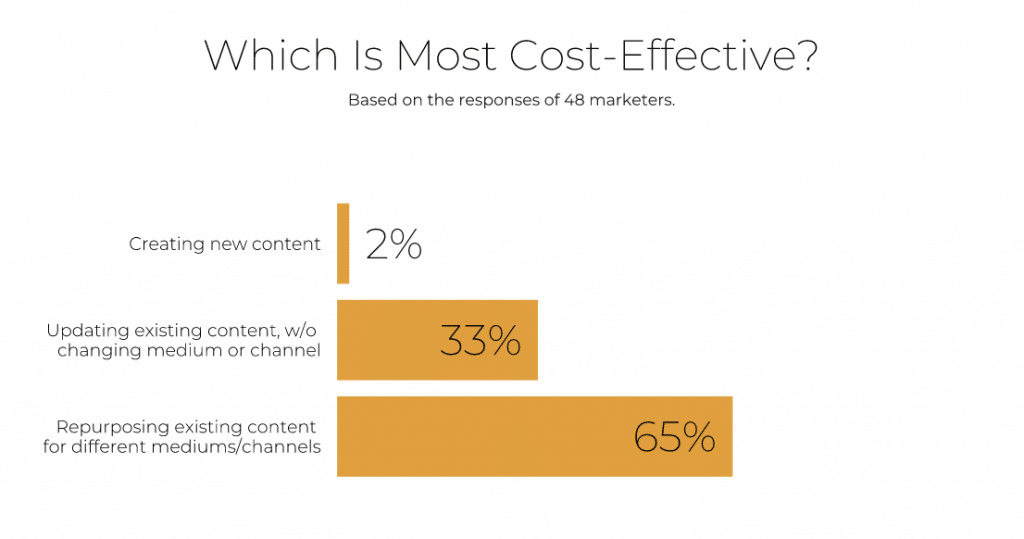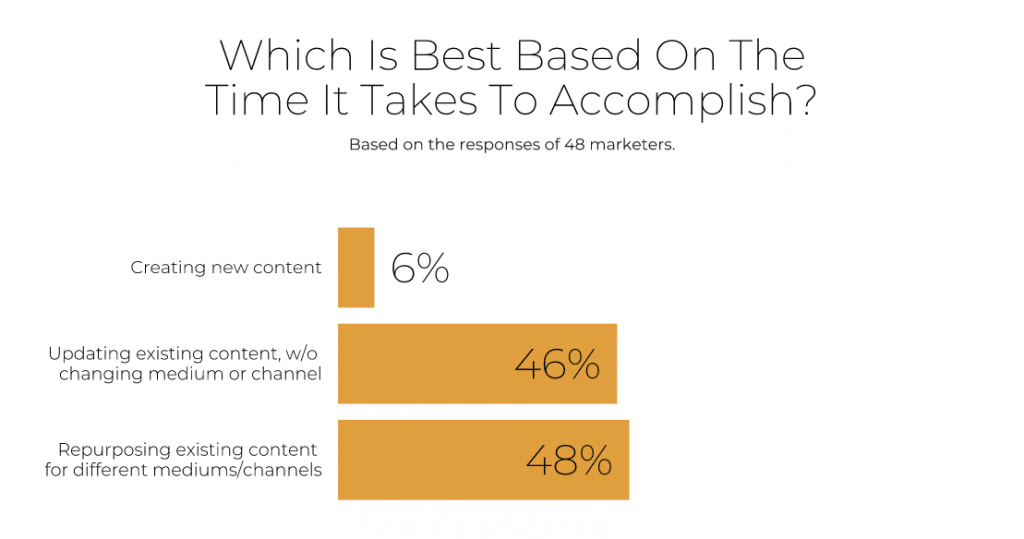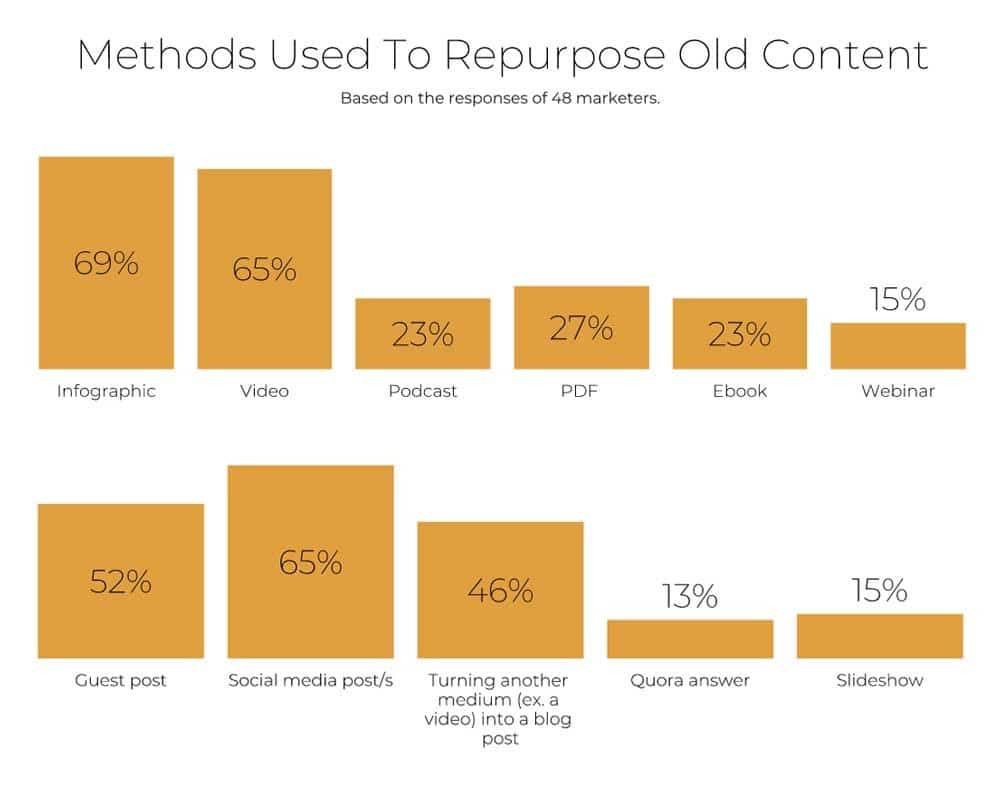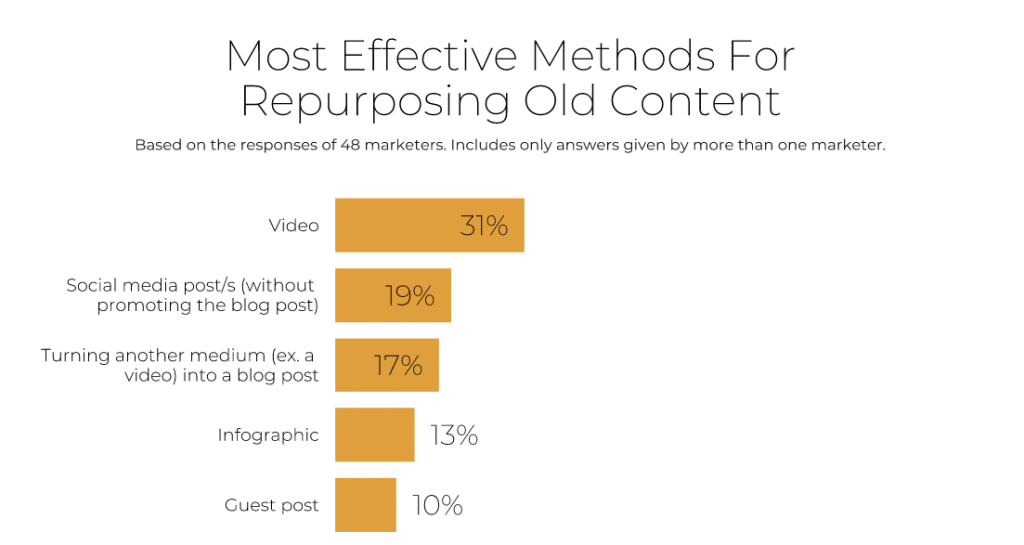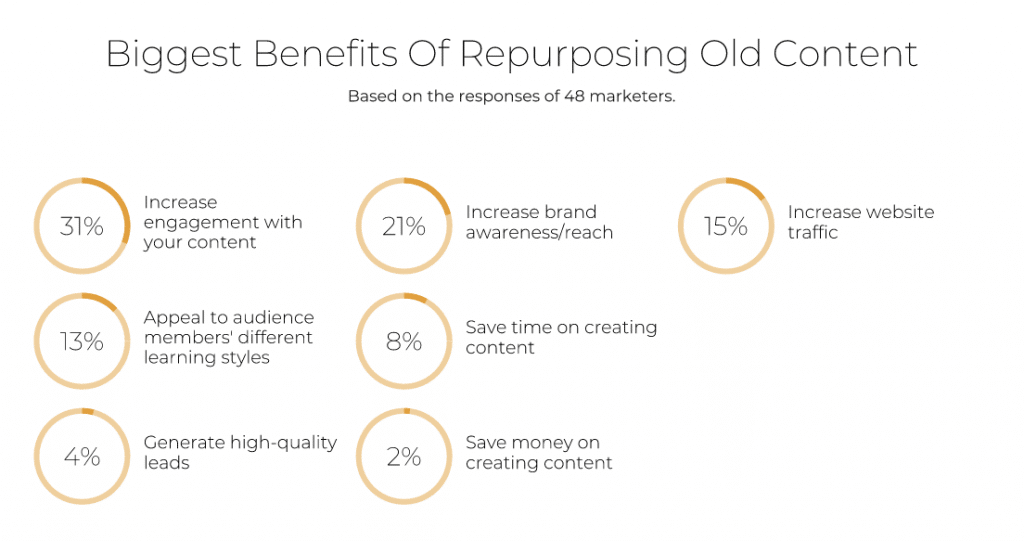Planning to repurpose more of your content? Good thinking.
Not only can content repurposing get you a wider audience for the content you’ve worked so hard to create (or paid so much to create), it can also save you time while keeping your content bank full to the brim.
But here’s the thing: Reusing content isn’t about copying what you’ve created on different platforms. It’s about understanding which content is worth recycling, how you can make it different while keeping the message the same, and so much more.
This guide digs deeper into tips like these, as well as the benefits of content repurposing. But first, let’s see how many marketers are recycling their content.
What do marketers think of repurposing their content
A whopping majority – 94% of the marketers we surveyed – repurpose their content. The remaining? They said they plan to do so in the future.
We also gave marketers the option of choosing “No, and we don’t plan to” work on content repurposing, but none of them opted for it. This alone tells us how important content repurposing is on a marketer’s to-do list.
Content creation vs. content repurposing vs. updating old content
We also asked our respondents to compare the results they saw from each of these three: creating new content, content repurposing, and updating old content.
Even when compared to other efforts, repurposing content took home the trophy as 46% of the marketers said it brought in the best results (leads, conversions, and so on). Following this, 33% said creating content gave them the best results, and 21% said updating content helped them the most.
Next, we questioned the costs involved. Again, repurposing content led the pack with 65% of the survey respondents saying it’s the most cost-effective strategy. Updating content came in second, with creating new content following in last.
We were also curious about the results achieved based on the work that each of the three categories requires.
Again, the majority of the marketers, at 48%, said reusing content was best based on the time it takes to accomplish. This time, updating content came in close with 46%, with marketers saying it gives them the best return for their efforts. Only 6% thought creating new content was the best use of their time.
Common methods of repurposing content
How do marketers repurpose their content? Depending on the original format (e.g., a blog post, a video, a podcast), there are many ways to recycle content in a fresh medium.
We asked marketers about the methods they personally use to repurpose content. This brought up interesting responses:
- The majority, 69%, of marketers reused content by turning it into an infographic
- 65% packaged content into videos and social media posts
- 52% repurposed content by publishing it on guest sites
- 46% said they turned content into another medium (e.g., repurposed a video into a blog post)
- 27% also adapted content into PDF format
- 23% packaged content into a podcast or an ebook
- 15% repurposed content into webinars and sideshows
- 13% reused content by sharing it as a Quora answer
The most effective method of reusing content
When it comes to the preferred way to repurpose content, marketers had their distinct preferences.
At the top, 31% of marketers picked video as the winning way to repurpose content, with 19% choosing social media as their most effective method. Conversely, 17% of marketers found turning another medium, such as a video or podcast, into a blog post, an effective way to repurpose old content.
The benefits of content repurposing
As for the benefits marketers saw from repurposing content, here are the key takeaways:
- 31% said content repurposing helping increased engagement with their content
- 21% said it helped with increasing brand reach/awareness
- 15% shared that reusing content helped increase website traffic
Aside from this, marketers also said repurposing helped them appeal to the audience’s different learning styles (13%), save time creating content (8%), generate high-quality leads (4%), and save money creating content (2%).
To better explain, Matt Zajechowski from Digital Third Coast shares the simple reason why you should repurpose content is: “To get more of an ROI on our content.”
Soberclear’s Leon Sylvester agrees: “I chose to repurpose content because it’s the fastest way to reach a larger audience, generate leads, and get more clients for my business. It’s cost-effective and if you’re willing to outsource the editing, it can be extremely efficient.”
As you can see, repurposing content provides a lot of benefits for your business. Let’s look at each one individually:
Repurposing saves you a ton of time
Jonathan Aufray of Growth Hackers applauds content repurposing for helping save time. “Repurposing content is very useful and allows you to create many pieces of quality content without spending too much time on it.”
Kerry Thompson of ClientsFirst echoes the same thoughts: “It’s a time-saving option to achieve a greater return. Not everyone will see your content the first time you post, so repurposing it and giving it a different look, but keeping the information similar, can help you achieve greater reach and engagement.”
It helps you reach a wider audience
“You need content for multiple channels in order to reach larger audiences,” insists Venngage’s Jeilan Devanesan. “You want to maximize the mileage you get from existing content. Reach as many people as you can, establish yourself as an authority on a topic, and create resources your target audience can refer to.”
Content Creators Agency’s Rebekah Edwards makes the same point: “If we share important content on one platform, the chances are it won’t be seen by people who follow our clients on another platform. And if it’s important enough to write, it’s important enough to share to each person who follows the brand.”
Danny Grainger of Danny Grainger Copy adds, “Repurposing content allows me to get the same material out to different audiences with different needs. Video and podcast content is personalized. In reality, not everyone will like my persona. I can provide the same information in an article without personal branding.”
It can further amplify your message
“Repurposing content is a way to amplify your marketing outreach without the extensive ground-work needed in creating new content,” points out Robert Stam of SEO Mandarin. “It also offers the potential for cross-linking different content mediums, which grows engagement, visibility, traffic, and leads.”
In short, “content is like a popular older movie. You can leave it out there in its original form and hope a new audience finds it, or you can be proactive and reboot it with a new audience in mind and exercise some control over pulling the value out of your asset,” summarizes Cable Compare’s Todd Ramlin.
Content repurposing: 13 tips to keep in mind
Now that you know about its many benefits, let’s walk through some tried-and-tested tips to repurpose content like a pro:
1. Make sure the content you repurpose is evergreen
“The first thing you need to do when repurposing content is to make sure the content you are repurposing is evergreen,” highlights Utah SEO Companies’ Tonya Davis.
“You also want to check how much traffic your content was receiving. If it had some interest then, it would likely have some interest now if you repurposed it.
“The next thing to consider is how you can improve upon it. You don’t want to just rewrite an old blog. You want to make sure it’s better than its predecessor, as well as competing articles. This is known as creating 10x content – content that’s ten times better than anything already floating out there. This requires research, time and effort, but has a very rewarding payoff.”
2. Look at your analytics to decide what to repurpose
“Dig into your analytics and figure out what works to help influence your repurposing game plan,” advises Kerry Thompson of ClientsFirst.
“Interesting statistics, insightful quotes, and actionable advice can make for an effective carousel, which have quickly become the most engaging type of social content. A carousel can offer an easy-to-read recap of your original content.”
3. Start by repurposing in-depth, long-form content
Two of our expert respondents highly recommend this. To begin with, Rachel LaVoie from The Limit DNE LLC shares, “Create the longest, deep-dive content first. It is so much easier to clip and snip a larger, more technical content piece than it is to continually create smaller pieces that may or may not fit together for a campaign.
“This way, a complete narrative is created, vetted out, reviewed by all parties and it’s easy to divide and conquer with one cohesive message.”
On the same note, RightlyWritten’s Oli Graham outlines, “My best piece of advice when it comes to repurposing content would be to find your most popular articles either over 3,000 words in length or dense with information.
“You can then break this post down into its relevant subsections, and rewrite it as guest posts. These guest posts can then naturally link back to your original, long-form piece of content. This will drive a nice little bit of traffic and ‘link juice’ back to your original long-form piece.”
4. Repackage interviews
Eliza Nimmick from Tutor the People talks about another useful content repurposing tip: “Interviews are a popular form of content for blogs. They’re easy to conduct (just email industry experts a quick question or two), easy to edit (mostly just a matter of copy and pasting), and usually get a ton of traction (as the folks you’ve interviewed share and promote the article they’re mentioned in).
“Repackage those interviews into a new form in the way of an expert advice ebook. You’re taking the exact same content and changing the medium.
“Some people prefer ebooks to blog posts, as they are easier to download and read later. Plus, your new expert advice ebook may get the attention of those who missed the interviews series the first time around.”
5. Get creative with how you can repurpose content
Growth Hackers’ Jonathan Aufray explains, “For example, when you write a blog post, you can easily repurpose this content by creating an image summarizing the post, and post that image on Instagram and Pinterest. You can also take quotes from the blog post and post them on social media.
“With a blog post, you can repurpose it by creating a video, an infographic, a slide, a social media post, and much more. Don’t just write a blog post, repurpose it!”
6. Use different mediums to reuse content
Danny Grainger suggests, “Repurposing content should send the same information, but to different audience personas. Using different mediums allows content creators and marketers to leverage personal vs. non-personal branding, which helps target a wider audience.”
7. Make the new content unique and relevant to form
It’s also essential you don’t go about just copy-pasting when it comes to repurposing content. To this end, Isoline Communications’ Anu Ramani highlights, “when repurposing content, don’t just blindly extract or copy from a previous asset. Make the new piece relevant to the form.
Take a unique angle that suits the form or is more topical based on what’s happening in the market at that moment, while keeping the kernel of the ideas intact.”
8. Write the same content in a different way
“Repurpose the same content. but write it a different way,” advises Kate Obert from Kate Obert, LLC.
“Each social media channel has its own purpose and how people want to consume the information on those channels are different. Instagram is more friendly, behind-the-scenes look. LinkedIn is more professional. TikTok is more silly, etc.
“Those are more guidelines than rules, though. I am a firm believer in breaking the mold, so why not see how people respond to ‘Instagram content’ on LinkedIn. You might stand out more.”
9. Repurpose according to each platform’s requirement
It’s also important to not forget each medium’s requirements. Cable Compare’s Todd Ramlin reminds, “Be familiar with what makes each medium/channel unique, and be sure your repurposed content is tailored appropriately.”
Sean Nguyen from Internet Advisor adds to this: “Work within the medium. Don’t try to make it as similar to the original content as possible. Try to make it the best video or blog post or course, etc. in its own right, just like you would with brand new content.”
Big Leap’s Adam Jackson warns, “Don’t just ‘copy and paste’ the message from the first piece into the repurposed piece. Repurpose the content, but also leverage the new medium’s unique advantages to add to, and enhance your message.”
Lastly, “Pay attention to content formatting as your reuse content,” recommends Nikola Roza of SEO for the Poor and Determined.
“My one tip is to pay special attention to content formatting on other platforms,” Roza elaborates. “In other words, don’t just copy and paste your blog post, hit publish, and you’re done. Instead, format the article as if you were writing a whole new piece.
“For example, formatting on Quora is vastly different from inside the WordPress editor. For one, there are no subheadings and your subheading can only be bold text. That makes it a bit hard to repurpose long-form content and still make it readable.
“Also, images cannot be aligned left or right. If you have too many, it’ll make your Quora answer very long and hard to read on mobile. No one wants to endlessly scroll down one page.”
10. Repurpose to Google Web Stories
Speaking of reusing content on different platforms and mediums, Tanner Rankin from Source Approach suggests, “The one content repurposing tactic that’s made my life easier, while also achieving results has been repurposing article summaries as Google Web Stories.
With Google’s prioritization of Web Stories to capitalize on the momentum of Instagram Stories, I’ve found building bite-size summaries into the end of each blog post not only helps with blog engagement, but also creates an easy copy and paste workflow to publish Web Stories quickly & easily.”
11. Make engaging images
“My favorite way to repurpose content across channels is to create engaging images for blog posts that double as social media posts,” shares Rebekah Edwards of Content Creators Agency.
“Images in SEO content can improve the interaction readers have with your piece (a great signal to Google that your content is worth ranking).
“If you think ahead and use images designed to engage and educate, it’s not hard to reuse the same thing on social media. For instance, an infographic can be repurposed into multiple square images on Instagram to create a full carousel.”
Chris Taylor from ProfitGuru notes the same, “I think one of the most effective and useful tips to repurpose your content is to turn your blog into interactive visuals in the form of infographics, quizzes, and videos.
“Because the human processes visuals 60,000 times faster than text, it’s far simpler for people to remember visual information than the same information in a written form. That is why marketing videos and infographics are all the rage and great for increasing traffic too.”
UpFlip’s Sergei Belous commends infographics for content repurposing, too. “Adding an infographic to existing content can be eye-catching and make the post prime for another medium, such as social media. They’re a great way to concisely explain the actionable tips within the article, adding great value.”
12. Leverage video for making the most of your content
“To maximize our reach, our marketing team will turn content pieces into videos,” Neal Taparia shares their team’s experience at Solitaired.
“We take a few sentences to summarize the article and use Lumen5 to create a 30-second video to summarize the article. It takes a few minutes. We then post this across social channels and reference the original article. It’s very easy and effective.”
SEO with Jenny’s Jenny Abouobaia remarks the same: “I have found the most effective way to repurpose content is by turning content from top-performing posts into video. Videos allow you to add and grow channels, like YouTube or Vimeo, which can attract a new audience.”
Ready to create engaging, repurposed videos? You’ll find these video content marketing ideas helpful.
13. Encourage people to view your other content
“One tip I’d suggest for repurposing content for different mediums is to create a necessity to view the other content source,” writes Robert Stam of SEO Mandarin.
“For example, in a YouTube video explaining basic on-page SEO best practices, I would include a prompt: ‘Go over to my article discussing this same topic and get the free landing-page template.’ This could potentially grow an email list and generate traffic to my site.”
Wrapping up
From converting blog content into eye-catching videos to creating visuals for your social channels from your latest video, there are tons of ways you can repurpose content.
But keep in mind: It’s not about simply copying and pasting. Reusing content is all about taking a unique angle and repackaging your content as per a platform’s unique requirements.
So what are you waiting for? Try out these expert tips to make the most of your content in no time.

